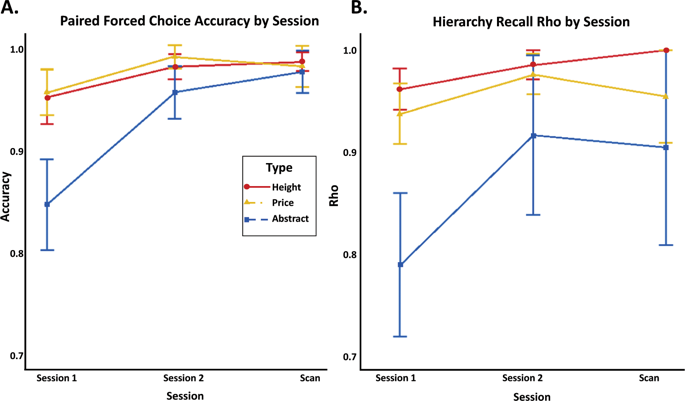当前位置:
X-MOL 学术
›
Commun. Biol.
›
论文详情
Our official English website, www.x-mol.net, welcomes your
feedback! (Note: you will need to create a separate account there.)
Mental models use common neural spatial structure for spatial and abstract content.
Communications Biology ( IF 5.2 ) Pub Date : 2020-01-09 , DOI: 10.1038/s42003-019-0740-8 Katherine L Alfred 1 , Andrew C Connolly 1 , Joshua S Cetron 2 , David J M Kraemer 3
Communications Biology ( IF 5.2 ) Pub Date : 2020-01-09 , DOI: 10.1038/s42003-019-0740-8 Katherine L Alfred 1 , Andrew C Connolly 1 , Joshua S Cetron 2 , David J M Kraemer 3
Affiliation

|
Mental models provide a cognitive framework allowing for spatially organizing information while reasoning about the world. However, transitive reasoning studies often rely on perception of stimuli that contain visible spatial features, allowing the possibility that associated neural representations are specific to inherently spatial content. Here, we test the hypothesis that neural representations of mental models generated through transitive reasoning rely on a frontoparietal network irrespective of the spatial nature of the stimulus content. Content within three models ranges from expressly visuospatial to abstract. All mental models participants generated were based on inferred relationships never directly observed. Here, using multivariate representational similarity analysis, we show that patterns representative of mental models were revealed in both superior parietal lobule and anterior prefrontal cortex and converged across stimulus types. These results support the conclusion that, independent of content, transitive reasoning using mental models relies on neural mechanisms associated with spatial cognition.
中文翻译:

心理模型对空间和抽象内容使用通用的神经空间结构。
心理模型提供了一个认知框架,允许在推理世界时在空间上组织信息。但是,传递推理研究通常依赖于对包含可见空间特征的刺激的感知,从而有可能使相关的神经表示特定于固有的空间内容。在这里,我们测试了一个假设,即通过传递推理生成的心理模型的神经表示依赖于额叶前额网络,而与刺激内容的空间性质无关。三种模型中的内容从明显的视觉空间到抽象。参与者生成的所有心理模型都是基于从未直接观察到的推断关系。在这里,使用多元表示相似性分析,我们表明,代表心理模型的模式在上顶叶和前额叶前叶皮层中均被揭示,并在各种刺激类型中收敛。这些结果支持这样的结论,即使用思维模型的传递推理与内容无关,依赖于与空间认知相关的神经机制。
更新日期:2020-01-09
中文翻译:

心理模型对空间和抽象内容使用通用的神经空间结构。
心理模型提供了一个认知框架,允许在推理世界时在空间上组织信息。但是,传递推理研究通常依赖于对包含可见空间特征的刺激的感知,从而有可能使相关的神经表示特定于固有的空间内容。在这里,我们测试了一个假设,即通过传递推理生成的心理模型的神经表示依赖于额叶前额网络,而与刺激内容的空间性质无关。三种模型中的内容从明显的视觉空间到抽象。参与者生成的所有心理模型都是基于从未直接观察到的推断关系。在这里,使用多元表示相似性分析,我们表明,代表心理模型的模式在上顶叶和前额叶前叶皮层中均被揭示,并在各种刺激类型中收敛。这些结果支持这样的结论,即使用思维模型的传递推理与内容无关,依赖于与空间认知相关的神经机制。











































 京公网安备 11010802027423号
京公网安备 11010802027423号